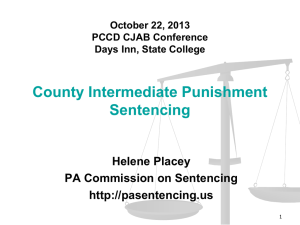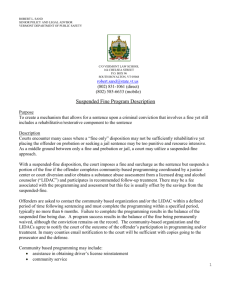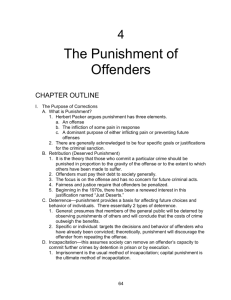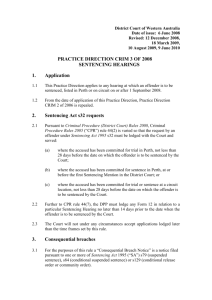Sentencing Process - Office of the Director of Public Prosecutions
advertisement
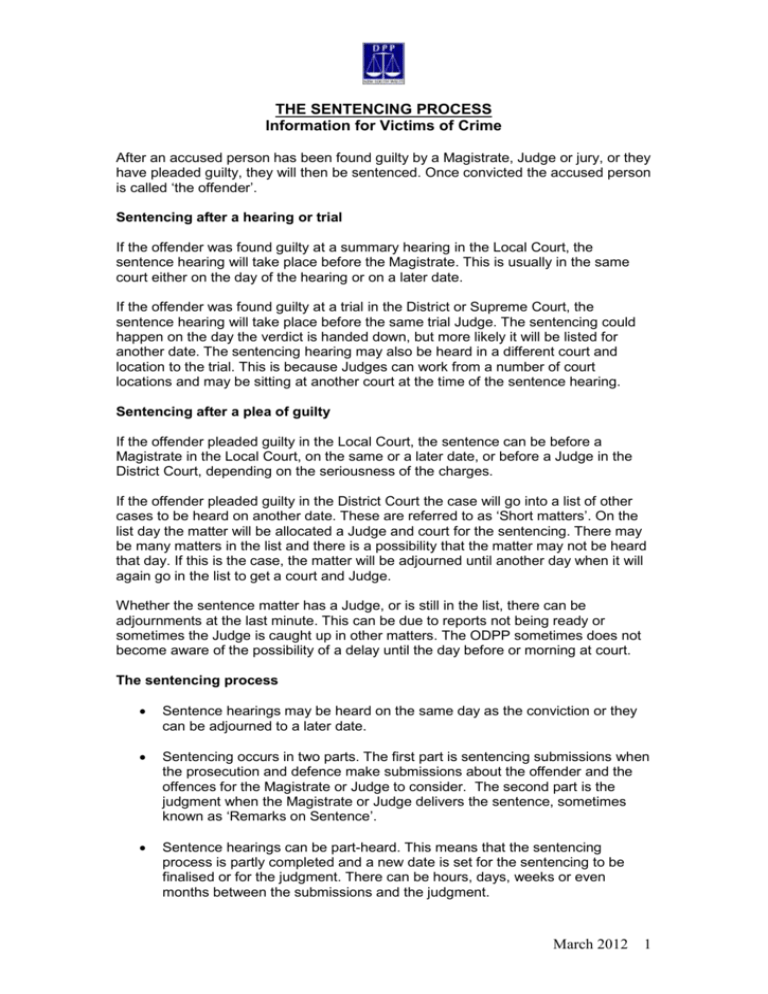
THE SENTENCING PROCESS Information for Victims of Crime After an accused person has been found guilty by a Magistrate, Judge or jury, or they have pleaded guilty, they will then be sentenced. Once convicted the accused person is called ‘the offender’. Sentencing after a hearing or trial If the offender was found guilty at a summary hearing in the Local Court, the sentence hearing will take place before the Magistrate. This is usually in the same court either on the day of the hearing or on a later date. If the offender was found guilty at a trial in the District or Supreme Court, the sentence hearing will take place before the same trial Judge. The sentencing could happen on the day the verdict is handed down, but more likely it will be listed for another date. The sentencing hearing may also be heard in a different court and location to the trial. This is because Judges can work from a number of court locations and may be sitting at another court at the time of the sentence hearing. Sentencing after a plea of guilty If the offender pleaded guilty in the Local Court, the sentence can be before a Magistrate in the Local Court, on the same or a later date, or before a Judge in the District Court, depending on the seriousness of the charges. If the offender pleaded guilty in the District Court the case will go into a list of other cases to be heard on another date. These are referred to as ‘Short matters’. On the list day the matter will be allocated a Judge and court for the sentencing. There may be many matters in the list and there is a possibility that the matter may not be heard that day. If this is the case, the matter will be adjourned until another day when it will again go in the list to get a court and Judge. Whether the sentence matter has a Judge, or is still in the list, there can be adjournments at the last minute. This can be due to reports not being ready or sometimes the Judge is caught up in other matters. The ODPP sometimes does not become aware of the possibility of a delay until the day before or morning at court. The sentencing process Sentence hearings may be heard on the same day as the conviction or they can be adjourned to a later date. Sentencing occurs in two parts. The first part is sentencing submissions when the prosecution and defence make submissions about the offender and the offences for the Magistrate or Judge to consider. The second part is the judgment when the Magistrate or Judge delivers the sentence, sometimes known as ‘Remarks on Sentence’. Sentence hearings can be part-heard. This means that the sentencing process is partly completed and a new date is set for the sentencing to be finalised or for the judgment. There can be hours, days, weeks or even months between the submissions and the judgment. March 2012 1 Sometimes the sentencing process can be difficult for victims or their families because of the focus on the offender rather than the victim. The sentencing process is mostly focussed on what the prosecution and defence want the Court to consider in deciding the appropriate sentence to give the offender. There are many factors considered by the Judge or Magistrate when deciding a sentence. Sometimes witnesses are called to give evidence about the good character or other factors affecting the offender. The prosecution and the defence may have provided written submissions so you might not hear them say a great deal in court. In other cases there may be legal argument about the agreed facts of the case. Both the prosecution and defence will refer to other cases that may have similar facts to this case and discuss the sentences received in those cases. If you are in court for the sentence you may hear the lawyers and the Judge or Magistrate discussing cases as “low range, mid range, and worst case”. This is the court trying to decide objectively where the facts of this particular case would fit in if you had to rank each case according to the seriousness of the facts. When the Judge or Magistrate reads out the judgment, the facts of the case are also read out in open court, though in some cases the name and details of the victim are not able to be reported. Victim Impact Statements (VIS) As a victim of crime, or family of the deceased victim, you may be entitled to write a VIS for the sentence hearing and if you wish, you or a representative can read the VIS to the court. A VIS can only be given to the court by the prosecutor after an accused is convicted and once the sentencing proceedings have begun. The offender is entitled to read the VIS but not to keep a copy of it. Reading out the VIS can only take place after the VIS has been handed to the Court by the prosecutor during the sentencing hearing. Each Judge has a different way of hearing the VIS read to the court e.g. the person might read the VIS from the public gallery, the witness box, or near the bar table, it depends on the Judge. You can have support when reading the VIS. Some victims are entitled to read their VIS via CCTV. Witness Expenses You will not normally be paid witness expenses to attend sentencing proceedings. In some cases, witness expenses may be paid for victims who submit or read their VIS to the court. Speak to the solicitor or WAS Officer about this. For more information refer to: Sentencing publications produced by Victims Services JusticeJouney Website: www.lawlink.nsw.gov.au/vs Victim Impact Statement Information Package About Victim Impact Statements – ODPP Fact Sheet Writing Your Victim Impact Statement – ODPP Fact Sheet March 2012 2



